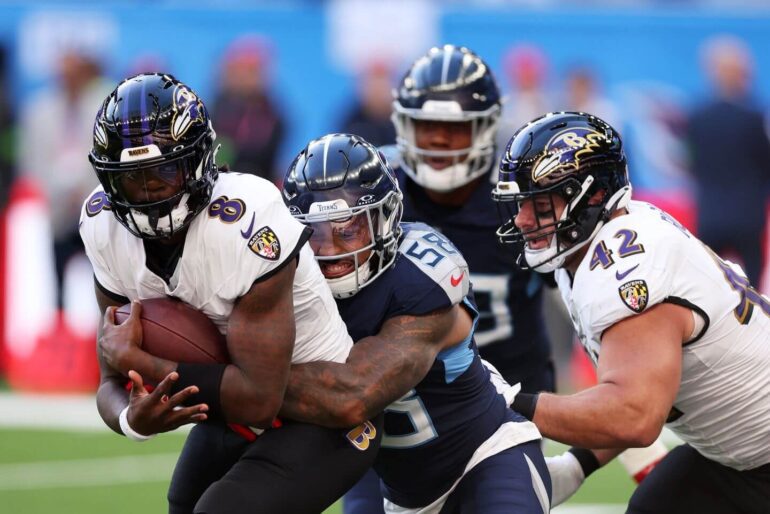TL;DR:
- AI technology is now used to swiftly detect on-field head impacts in NFL games, reducing analysis time from 12 hours to minutes.
- The NFL is using this technology to improve player safety by identifying high-impact situations and enhancing equipment.
- Rugby union has adopted smart mouthguards that flag significant hits in real-time, aiding in immediate head injury assessments.
- These innovations are pivotal in addressing brain injuries in sports, driven by medical and ethical concerns.
- The use of biomarkers and advanced sensors in helmets may further enhance injury assessment and prevention.
- The future may see sports like boxing employing technology to halt bouts when high concussion risks are detected.
- Ongoing research aims to refine impact assessment criteria and explore long-term load tracking benefits for players’ welfare.
Main AI News:
In the heart of the NFL action between the Baltimore Ravens and Tennessee Titans in London, an unexpected observer took center stage: artificial intelligence. In a remarkable fusion of technology and sports, computers have been trained to swiftly detect on-field head impacts in the NFL using multiple camera angles and advanced machine learning algorithms. What once consumed a painstaking 12-hour process for each game is now accomplished in mere minutes. The outcome? Every weekend, teams receive a comprehensive breakdown detailing which players endured hits and the frequency of these incidents.
This technological wizardry serves a profound purpose. Dr. Allen Sills, the NFL’s Chief Medical Officer, revealed over breakfast how this innovation plays a pivotal role in minimizing head impacts and propelling equipment evolution. Players subjected to high numbers of head impacts can receive targeted coaching to improve their techniques. Moreover, nine NFL quarterbacks and 17 offensive linemen have adopted position-specific helmets, engineered with extra padding in areas prone to greater impact.
What lies on the horizon? The integration of precise sensors within helmets, capable of estimating the force of each tackle, stands as a promising endeavor. Another avenue of exploration involves the utilization of biomarkers, such as saliva and blood, to gain a deeper understanding of when injured players can safely return to action.
As if this wasn’t impressive enough, the realm of rugby union recently embraced smart mouthguard technology, marking a pioneering leap. Starting in January, elite players who experience impactful tackles or rucks exceeding a defined threshold will undergo an immediate head injury assessment by a physician.
Dr. Eanna Falvey, World Rugby’s Chief Medical Officer, aptly dubs this innovation a “game-changer” for potentially uncovering a significant portion of concussions that only come to light post-match.
Smart mouthguards, AI, and biomarkers have become the forefront of the battle against brain injuries in sports. This technological surge is driven by medical, ethical, and legal imperatives, particularly in the face of alarming stories of former players and mounting lawsuits against organizations like the NFL and World Rugby. However, it also triggers intriguing contemplation: what implications might these advancements hold for sports in the coming decades?
Consider the sport of boxing. If a smart mouthguard can promptly signal that a punch carries a 90% chance of causing a concussion, should the bout not be immediately halted? This paradigm shift raises profound questions for both fighters and sanctioning bodies. Can the status quo persist when an independent doctor is instantly alerted to a potential brain injury during a fight?
Engaging with Dr. Ross Tucker, a science and research consultant for World Rugby, makes it evident that we have barely scratched the surface of how smart mouthguards and other technologies can enhance sports safety. Presently, World Rugby factors in G-force and rotational acceleration to determine when a player should be automatically removed for an HIA (head injury assessment). In the upcoming years, they aspire to refine their ability to identify impacts with clinical significance, necessitating an exploration of additional variables such as impact duration and direction.
Tucker envisions a future where four impacts above 40G might equate to the same injury risk as a single impact above 90G or where three impacts within 15 minutes, regardless of magnitude, elevate risk similarly to one at 70G. The possibilities are vast.
Furthermore, the potential to employ smart mouthguards for long-term load tracking presents itself. “Assisting in identifying concussions is one facet,” Tucker notes, “but enabling coaches and players to monitor their career’s significant head impacts, especially in training, carries performance and welfare advantages.”
Meanwhile, new research from the University of Exeter’s Head Impact, Brain Injury, and Trauma research group unveils the perils and complexities surrounding combat and collision sports, particularly boxing. Their study involved 18 amateur boxers subjected to various trials, including boxing matches and time spent hitting pads and resting. The researchers examined the alterations in brain blood flow after each trial, even though none of the fighters suffered concussions. The results yielded concerning insights.
Dr. Bert Bond, the study’s lead researcher, emphasizes that “there was an alteration in the ability to regulate brain blood flow—even in healthy boxers—and the magnitude of this change was associated with the number of times the boxer was hit in the head.” In essence, even without apparent concussions, subconcussive hits had a discernible impact on neurophysiology.
Bond, who also investigates lifestyle factors that increase the risk of dementia, underscores the link between head impacts over a lifetime and long-term health outcomes.
Conclusion:
The integration of AI and smart mouthguard technology into sports safety measures is a transformative step forward. It addresses critical concerns about player well-being and injury prevention, which holds significant implications for the market. Companies specializing in sports technology and medical equipment are likely to see increased demand as sports organizations prioritize safety and performance optimization. This convergence of technology and sports is poised to reshape the industry in the coming years, creating new opportunities and standards for safety across various sports.

